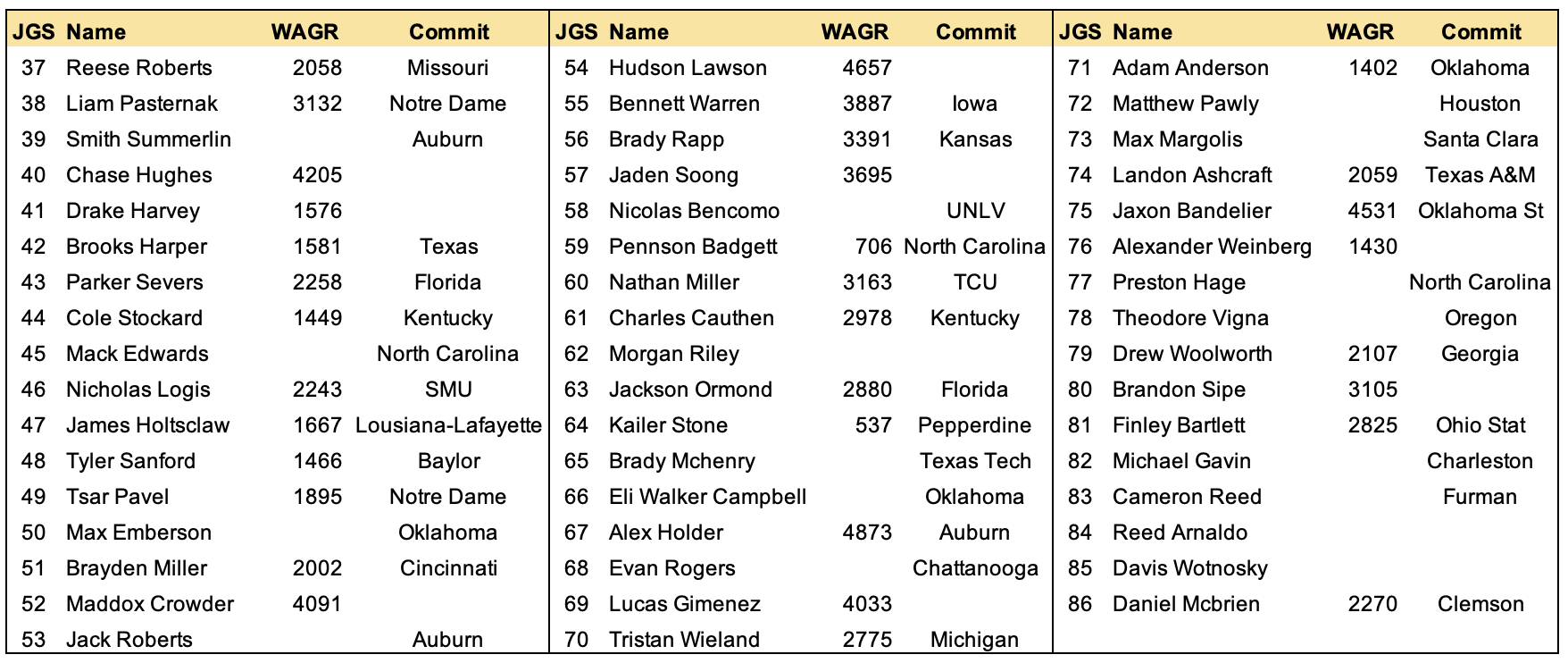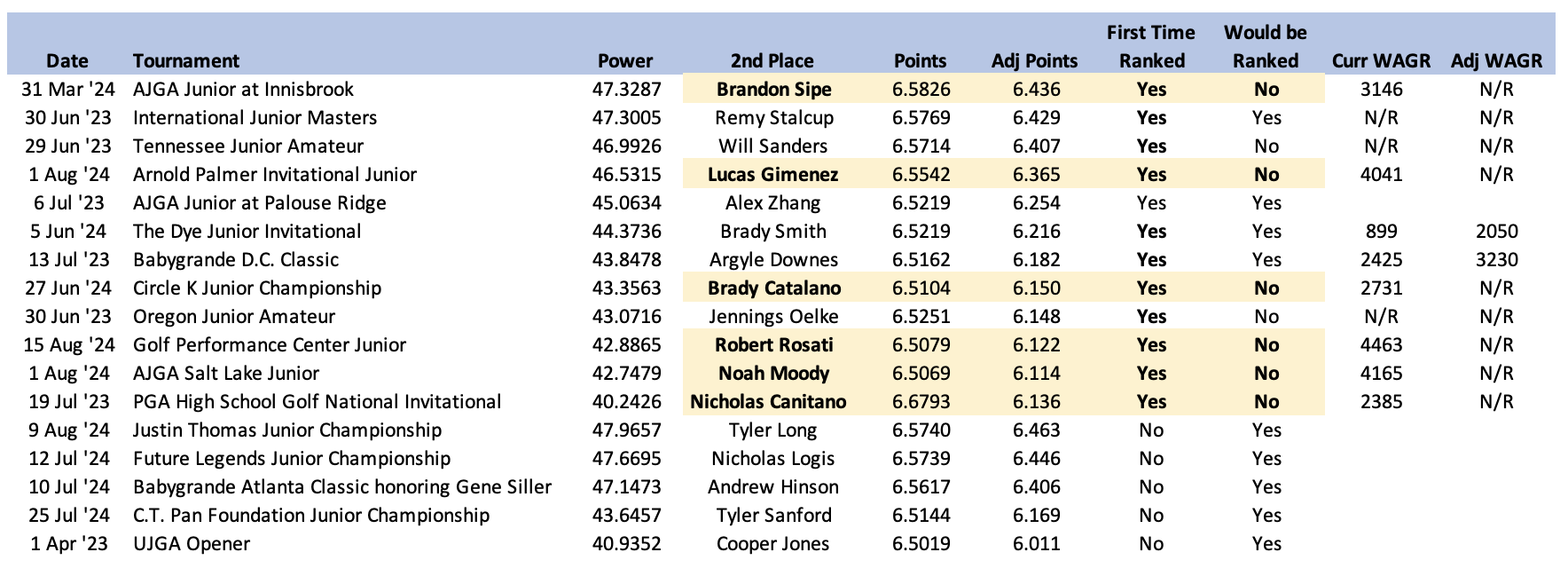
Related Content

Inspiring golfers to pursue this great game with drive and passion
Keywords
Related Posts

WAGR Files: WAGR Whac-A-Mole (Part III: U.S. Junior Exemption Impact)
2025 WAGR Changes may impact the exemption status of up to 30 Junior Golfers

WAGR Files: WAGR Whac-A-Mole (Part II: Staying Ranked)
How are the 998 Junior Golfers on WAGR impacted by the 2025 Changes?
WAGR Files: Junior Golf in Jordan
A look at the latest hotbed of junior golf in the world, according to WAGR
Earlier this week, The R&A and USGA announced changes to the WAGR system that will become effective January 1, 2025. The changes are aimed at addressing perceived weaknesses in ranking accuracy of smaller, weaker field events which have created outliers like those observed in our recent post about junior golf in Jordan. This post attempts to take a deep dive into the changes, assessing both the intended and perhaps unintended consequences to junior and amateur golfers.
The 2025 changes effectively try to address the outlier issue head on, via two modifications:
Increasing the minimum field size for mens and mixed events from 8 to 16 players
Decreasing the point allocation by finish position for events with a Power of 50 or less, by up to a third
The WAGR press release specifically noted that "there has been a noticeable rise in smaller tournaments with weaker fields. Many of these events have minimum field sizes but feature few, if any, ranked players. As a result, a large portion of participants are unable to post scores that meet an elite standard, with a significant number of players not completing the competition." I can't help but wonder if they were referring to the GEM International Amateur Invitational event in the United Arab Emirates that we highlighted in our Jordan post. You may recall this was a mixed event with only six players finishing, yet had a WAGR power ranking above at least 56 AJGA events in 2024. Maybe the USGA and R&A are avid readers of the DRVN.Golf blog!

There's no doubt that if this event were held under the new rules it would not be WAGR eligible and the winner Mousa Shana'ah would not receive the nice 8.1158 point WAGR boost. So from that perspective, the changes to the minimum field size address the "small, weak field" issue head on. However, the golf federations and event organizers are motivated to conduct WAGR-eligible events, so I think it's safe to assume they will respond in kind. This likely means that they just move from "small, weak field" events to "slighty bigger, but still weak field" events by filling the bottom half of the field with even more cannon fodder. Will winning the 2025 Rando Junior Open against 14 non-competitive players be any more impressive than winning the 2024 Rando Junior Open against six non-competitive players? While the minimum threshold might eliminate some events from the calculation and the artificial points boost that comes along with it, I anticipate the impact of this change will be minimal due to how the federations and golf organizations respond to the new threshold.
Points Reduction for Low-Power Events: A Fallacy with Unintended Consequences
Even more impactful is the points adjustments down for those events with Power below 50 (by up to a third). Avid DRVN.Golf readers will know that the Power Ranking is calculated as the weighted sum of the players in the field, with each player contributing based on an inverse of their WAGR ranking (i.e. the 400th ranked player would have a contribution twice that of the 800th ranked player) and the best player contributing a higher weight than the second best player in the field etc. The points assigned to the winner is a simple formula of Points = 7.5 + 0.0175 x Power (you can confirm in the tournament above: 35.189 * .0175 + 7.5 equals the 8.1158 points Mousa received for winning).
The details on how this "up to a third" adjustment will be implemented are unclear, but I'm assuming by the use of "up to" that it will be a sliding scale where tournaments closer to 50 will get less of an adjustment than those with minimal Power. I guess we will know for sure on January 8th, 2025 (expect a follow up post). But for purposes of this post and all of the subsequent analyses, let's assume the adjustment is linearly scaled from 0 for those at 50 Power down to -33% for those at 10 or less Power. In other words, a tournament with a Power of 30 (half way between 10 and 50) would get a -1/6th downward adjustment for the winner and all of the other finish positions.
There's no doubt that, in the example above, Mousa Shana'ah would receive less points for winning the GEM International Am than he did before, lowering his average points per tournaments and, all else equal, his WAGR ranking. Using our sliding scale, his 8.1158 points would go down to 7.1141 (down 12.3%). So from that perspective, mission accomplished for the R&A and USGA. They've successfully targeted and adjusted down those events with few ranked players and a large portion of participants that are unable to post scores that meet an elite standard.
However, do you know what other tournaments have below a Power of 50? Larger field tournaments with few, if any ranked players and lots of players who ARE able to post scores that meet an elite standard. That pretty much describes the junior golf landscape in the U.S. on the boys side. Remember the 56 AJGA events referenced earlier? They would all receive a larger downward adjustment than the event mentioned above.
For reference, a hypothetical 50-player tournament with the 37th through 86th ranked golfers in the U.S. according to Junior Golf Scoreboard, with at least 30 high-level D1 golf commits would receive a power rating of 44.06 and a 5% downward adjustment. For what it's worth, this would be a 150-point AJGA event, the highest point category that an AJGA Open event can have.

The fallacy here is that the R&A and USGA treat all unranked golfers as the same, assuming they are replacement level (worse than the worst ranked golfer on WAGR) whether they are competitive or not. Even their press release admits there is difference between unranked golfers who "cannot shoot scores at an elite standard" and presumably those who can. For example, the unranked golfers in the tournament above have a scoring average of 72.7 in WAGR-eligible events.

This is the time to point out that the R&A has all of the WAGR tournament scores on these unranked golfers and chooses to ignore it for their Strength of Schedule purposes. That might be the biggest fundamental flaw of them all. The biggest "accuracy" issue with WAGR is that it is exceeding hard for a U.S.-based junior to a) get ranked and stay ranked and b) get ranked accurately. The issue drags down the Power for all U.S. junior events, making it less accurate for those who are ranked. And in its attempt "refine the ranking system to accurately reflect player performance" with these changes to "small, weak field" events, they've actually made it harder for a U.S. player to be ranked and more difficult to be ranked accurately than ever before. By trying to solve one issue, they may have exacerbated another.
The Second-Place Sweet Spot & WAGR Cancel Culture
For many of these lower Power ranked events, only the winner would receive the minimum 6.5 points needed to become a ranked player. The R&A and USGA rightfully put in a provision with this downward adjustment to ensure the winner would still remain ranked even if the adjusted points were below 6.5. For example, the winner of a 10 Power event would receive 7.675 points under the current regime and 5.117 points under the new regime starting in 2025, but would still become a ranked player in both cases.
While winners would be protected under this change, there's a spot where the Points rating for a solo second place finisher are enough to also get the 6.5 points needed to become a ranked player. The 2nd place points assignment varies by the size of the field, but is typically around 78.8%-79.1% of the points of the winner. In your typical 51-person AJGA event, 2nd place receives 78.83% of the winner. That means that a tournament would need a Power Rating of 42.6 or more to get the 6.5 points needed to become ranked. So essentially there is a sweet spot between 42.6 and 50.0 where a 2nd place finish would've been ranked under the old regime, would get adjusted downward under the new regime and perhaps to a level below the 6.5 points required to be ranked. The net result will be less ranked players by definition.
A quick survey of junior events in the U.S. in the last two years shows 17 different events in this sweet spot where the solo 2nd place finisher received more than 6.5 points and below 6.5 points under the 2025 changes. Of those 17 performances, 12 of them were the thing that got the player ranked in the first place. And of those 12, three would've earned a ranked spot at a future date (but would have a lower current rating). Six of the 12 would not be ranked players today if the second place performance were adjusted below the 6.5 point threshold (i.e. they haven't earned 6.5 points since). That is wiping out about 5% of the total ranked U.S.-based junior players (and likely more once we get to Part II).

The Vicious Cycle of these WAGR Changes
It's important to note that the impact of these changes goes well beyond the unfortunate impact to these six players. Every subsequent event would then treat them as unranked, no better than a 90s-shooter at the bottom of the leaderboard. This impacts the Power rankings for the next event they are in and the Points assignment for every ranked player in the field. For instance, take a junior event with the six golfers above plus Brady Smith and Argyle Downes. It would have a Power contribution up to 11 points higher using their current WAGR instead of being unranked or, in the case of Smith and Downes, a lower WAGR from not becoming ranked until a later date. Today's 55-point event could become tomorrow's 44-point event, potentially preventing yet another 2nd place finisher from becoming ranked. And the cycle continues.
It's critical to understand whether changes to WAGR are directionally correct, as any errors or unintended consequences get amplfied over time.
Before We Go: A Proposed Solution
We'll cover other aspects of this proposed change in future blog posts. But before we go, here's a simple way to offset the broader, unintended consequences of these changes. Similar to the provision that stipulates the winner becomes a ranked player regardless of the point threshold, do the same for 2nd place and 3rd place based on the field size. I submit the following as a suggestion:
48-player field or greater: solo 2nd becomes ranked, regardless of adjusted points (i.e. even if it's below 6.5)
72-player field or greater: T-2nd or solo 3rd becomes ranked, regardless of adjusted points (i.e. even if it's below 6.5)
This simple stipulation would allow for the announced changes to target the smaller, weak field events while lessening the damage to larger field events.
To be continued...
Part II: The Challenge of Staying Ranked
Part III: The Impact to US Junior Exemptions
Part IV: The Impact to Women's Golf
Free E-mail Newsletter
Subscribe to the DRVN Golf Newsletter
DRVN Golf in your inbox, every month